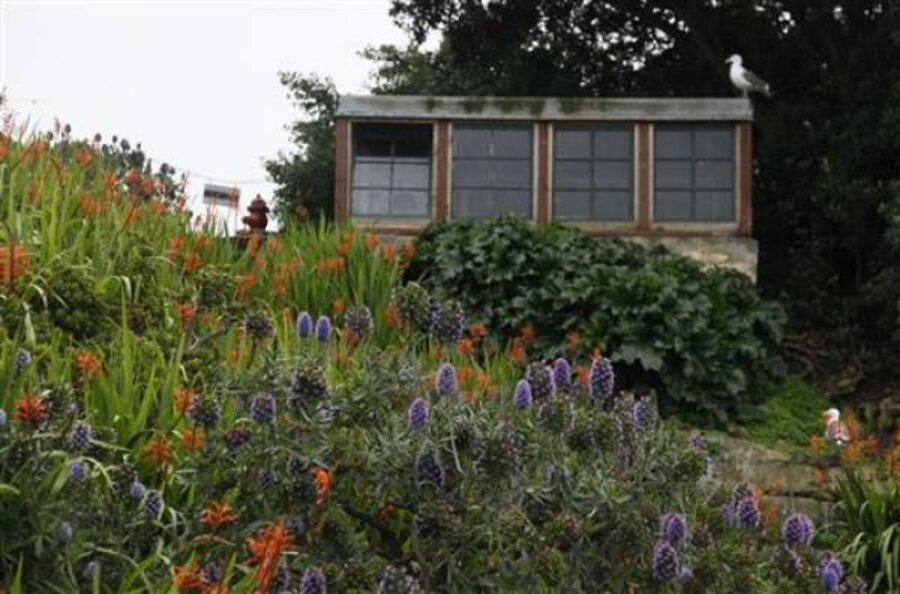The rocky shores of Alcatraz bloom once again
Loading...
| SAN FRANCISCO
Scoured by wind and steeped in criminal history, Alcatraz has a forbidding face. But look a little closer and you see a gentler side to this old fortress, the gleam of flowers blooming brightly on the island's rocky slopes.
These are the gardens of Alcatraz, once tended by prisoners and the families of the guards who watched them, now being revived by a band of conservationist sleuths who rely on old photos and long memories to re-create an almost forgotten piece of horticultural history.
"It really is a jigsaw puzzle — it takes some detective work," says Shelagh Fritz, project manager of the Gardens of Alcatraz. "Our goal is to turn a place of neglect and harshness into something that's beautiful and worth taking care of."
Memories of what it was like
Kathe Poteet remembers how the gardens used to look. Her father, Al Kaeppel, was business administrator on the island in the 1950s, and she lived on the island until she was 7.
"It was a great place to grow up," says Ms. Poteet, now a teacher in central California. She remembers playing on the parade grounds, picking berries in the fall, and chewing on sour grass, the tasty weed known as oxalis.
A ground cover plant known as Persian carpet covered the slopes near her house, making a display that could be seen from the boat when traveling back from trips to the mainland. "When that was in bloom, the whole island just would look pink as you were coming home."
Originally a bald lump of an island — they don't call it The Rock for nothing — Alcatraz became an Army fortress in the 1800s and a military prison in 1861. From 1934 to 1963, it was the federal penitentiary commemorated in a slew of Hollywood films such as "Birdman of Alcatraz" and "Escape from Alcatraz."
In the early 1900s, military and civic projects brought trees, shrubs, and seeds to the island. The movement got a boost in the '30s when Freddie Reichel, secretary to the warden, persuaded the prison leader to allow inmates to garden, a privilege granted only to the best-behaved.
It was uphill work. "I kept no records of my failures, for I had many," Mr. Reichel wrote in a letter chronicling his efforts.
It doesn't appear that the island's most infamous resident, mobster Al Capone, showed any flower power. But in the '40s, prisoner Elliott Michener left his mark, working in the gardens on the island's West Side where he laid out flower beds and put together a tool shed from odds and ends. The shed, recently refurbished by National Park Service carpenters and volunteers, still stands.
Michener liked his work so much that for a while he turned down parole to stay on, says Fritz, although he eventually left and went to work at a dairy farm in Wisconsin.
After the prison closed in 1963, partly due to high operating expenses, the gardens fell into disarray — flowers died back, shrubs grew into misshapen monsters, and weeds ran wild. But more than 200 species — shrubs, succulents, bulbs, and perennials — survived.
The progress of the restoration
The restoration dates back about six years when the Garden Conservancy, a national nonprofit group dedicated to saving significant gardens, opened a West Coast office.
It started looking for a project, and someone suggested Alcatraz, says Antonia Adezio, president of the Garden Conservancy. "We just became tremendously excited about the potential to show the public how important gardening is. Here they were in this desolate place and finding ways to connect with it."
The conservancy is working in partnership with the Golden Gate National Parks Conservancy and the National Park Service. Late last year, the gardens were recognized with the California Preservation Foundation Trustees Award for Excellence.
Gardening on a rock's not easy. All fresh water still has to be brought in by boat.
This year, a 15,000-gallon water cachement system went in, which should provide enough water to keep the gardens irrigated year-round.
As spring beckoned, flowers in bloom included the bright blaze of yellow narcissus and the softer lavender of iceplant climbing up a west side bank. Gardeners are doing battle with another import to the island: the weedy oxalis that apparently seemed a good idea back in the early 20th century.
Other highlights include a rose garden, in which restorers found a Welsh rose, Bardou Job, that hadn't been seen in Wales for years. Welsh gardeners were given a cutting.
Along the way, workers have uncovered more than botanic secrets.
One of the resources being used by restorers are some paintings done by a former inmate that show views of the west side gardens looking toward the San Francisco skyline.
The inmate's family, who never knew about the man's time in prison, found the pictures after he died and puzzled over them for a while. Where could they have been painted? Slowly, it dawned on them, he had to have been on Alcatraz — at a time when the island wasn't open to day excursions.
Poteet's island memories live on in her backyard.
When they left the island, her parents took some cuttings from their gardens. Descendants of those plants now grow at her home in central California, and Poteet, who has worked as a volunteer on the garden project, gave restorers some of the cuttings.
"Full circle," she says.
-----
To read more about gardening, see the Monitor's main gardening page and our lively gardening blog, Diggin' It. Both of these have changed URLs, so we hope you'll bookmark them and return. Want to be notified when there's something new in our gardening section? Sign up for our RSS feed.






